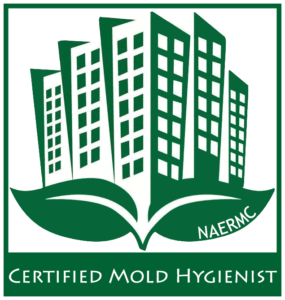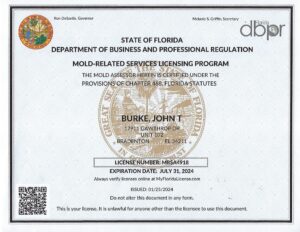
Owner, Burke Environmental Services
John Burke is the owner of Burke Environmental Services, serving southwest Florida’s Sarasota and Manatee counties.
John is a certified Mold Hygienist and a Certified Green Indoor Air Quality Specialist.
When testing for mold, it is imperative that you use the services of a certified professional.
A routine assessment should include environmental testing, sampling the environment for mold and allergens, evaluation of the property for moisture intrusion/water damage, pre and post-remediation mold assessments, and development of protocols for mold remediation.
Additionally, the inspection might include thermal imaging, moisture meters, hygrometers (to measure humidity and vapor pressure) and spore sampling.
Types of Mold Sampling
Visual Sampling
A non-intrusive visual inspection is considered the lowest level of confirmation of mold.
Air Sampling
When visual confirmation cannot be made the next level of confirmation of mold would be sampling and laboratory analysis which includes swabs, tapes and bulk samples and air sampling. An independent environmental laboratory conducts the final mold analysis and will confirm the type and quantity of mold present. Air sampling is the most accurate and common method for determining exposure. It involves collecting air samples from various areas of your home and analyzing them for the presence of mold spores. Air sampling can identify the type and concentration of mold spores in your home.
Surface Sampling
Surface sampling involves collecting samples from surfaces in your home, such as walls, floors, and furniture, and analyzing them for the presence of mold. Surface sampling can identify the mold type present and the mold growth extent. However, it may not be able to detect hidden mold growth, and the results can be affected by various factors such as the type of surface and the sampling method used.
The following are typical steps taken by the mold inspector:
- Initial consultation: The mold inspector will conduct an initial consultation to assess your concerns and identify any potential areas of mold growth in your home.
- Visual inspection: The inspector will visually inspect your home for any signs of mold growth, such as visible mold or water damage.
- Testing: Depending on the type of test selected, the inspector may take air, surface, or bulk mold samples from your home.
- Lab analysis: The samples will be sent to a laboratory for analysis to determine the type and extent of mold growth present.
- Interpretation of results: Once the lab results are available, the inspector will interpret them and provide you with a report detailing their findings.
- Recommendations: The inspector may suggest mold remediation and prevention
based on the results.
The mold testing process typically takes a few days to a week, depending on the type and number of samples taken and the lab turnaround time.
The inspector will provide detailed instructions on preparing for the testing and what to do after the testing is complete. It is vital that you follow these instructions carefully for accurate results and to prevent mold growth in your home.
If you suspect the presence of mold in your home or place of business contact Burke Environmental Services.



